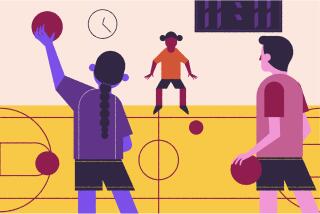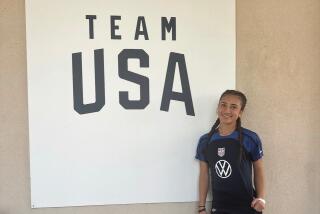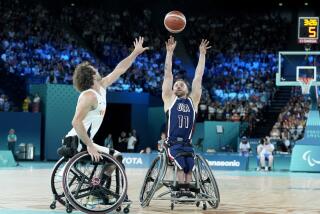Young Roller-Hockey Players Get the Short End of the Stick
SADDLEBACK VALLEY — As the sun rises over a black asphalt parking lot near a school, the hyperkinetic kids don their skates and begin practicing the fine art of drilling the slap shot.
Their coaches keep one eye on the players and the other peeled for a security guard or principal who is apt to appear and immediately banish them from the schoolyard.
Roller hockey, the new youth sport rage in Southern California, for some kids is replacing traditional sports and creating hockey hotbeds in such communities as Anaheim, Huntington Beach, Fullerton and Mission Viejo.
No Little League or Pop Warner-style organizations guide this sport, which is why nobody can estimate how many youths participate in roller hockey.
But in places like Side By Side Rinks in Huntington Beach--one of the few true roller-hockey facilities in the Southland--league play goes on 23 hours a day. Seven days a week, older teen-agers and adult players show up at 1 a.m. for the start of the final set of league games.
As the sport grows, so do the number of Orange County school districts that are banning the activity from campuses, where hockey teams, which have few other places to go, secretly play on weekends and in the early hours before school.
“We have visions of some youngster being run over in the parking lot, and we have liability,” James A. Fleming, superintendent of the Capistrano Unified School District, said. “It’s not within our basic mission to provide roller-hockey facilities. Our mission in school is reading, writing and arithmetic.”
*
Districts throughout the county increasingly find themselves putting a damper on the pastime.
“Our security people on weekends have chased some kids and young adults off of our school sites,” Brad Lantz, student services director for the Tustin Unified School District, said. “Liability and damage to school property is a problem here. We don’t allow unauthorized use of our facilities.”
These are the obstacles throughout Orange County as pint-size Wayne Gretzky wanna-bes pour out of neighborhood cul-de-sac pickup games, looking for organized teams and a place to play.
The situation has also posed a minor law enforcement problem as police officers encounter weekend hockey games on school property and are forced to clear out the players.
“The police come out and tell us to leave, the principals come out and tell us to leave; I think it’s really stupid,” said Brian Fletcher, 17, who plays for the Mission Viejo Panthers, a junior team.
“We’re not breaking windows, we’re having fun,” he said. “It makes you think they’d rather have us out after curfew, getting into trouble.”
For Fletcher, “roller hockey is the best sport in the world. You get going so fast, you get so much speed, it’s kind of a rush. Then when you score a goal, you get really pumped.”
Its popularity was made possible by two events, enthusiasts agree: the successful marketing of in-line skates--a series of wheels set in a single line between the heel and toe--and the celebrity of Los Angeles Kings’ ice hockey superstar Gretzky.
“Its popularity has just mushroomed, it’s being played in the streets everywhere,” said Alan Trudell, spokesman for the Garden Grove Unified School District.
While the problem largely is felt by schools, some cities are concerned enough about liability to also take a hard line.
*
Trudell said his 9-year-old son and his friends have been shooed away from parks by city employees in Anaheim Hills. He said his son’s love for roller hockey has overpowered his desire to play football or baseball.
John Black, who managed Roller Hockey International’s Los Angeles Blades franchise last year, organizes youth roller-hockey tournaments throughout Southern California and has witnessed the game’s phenomenal growth.
“You can see the gleam in a kid’s eyes when they talk (roller) hockey,” Black said. “The word you hear over and over is addictive. This sport has really taken root, and it’s definitely here to stay.”
Black and other roller-hockey organizers say the lack of proper facilities is the only thing holding the game back.
The sport got a boost last year when professional roller hockey became a reality with the formation of the 24-team Roller Hockey International, giving young people a chance to dream of turning pro.
“That’s one of my goals, I want to be in (RHI) so bad,” said Fletcher of the Mission Viejo team.
Sherri Naona, who was a Little League and soccer mom, has watched roller hockey virtually take over the lives of her 16-year-old son, Jason, and his friends.
“These kids just live hockey,” she said. “All they have time for is school and hockey, school and hockey. I’ve never seen a group of kids so focused.”
Players will go anywhere they can find a smooth surface. Enclosed tennis courts are attractive, and garage structures will do in a pinch. But tennis players and moving automobiles have first dibs on the space.
“I started playing three years ago in my shoes with a stick and a ball,” said Jason Naona, who now plays with Fletcher on the Panthers team. “We’d put a couple pieces of tape on the ground for the goal. You can play roller hockey any time you want, and I used to play it every day after school.
“It’s faster and more exciting than baseball or soccer,” he said. “You can make moves you can’t do anywhere else. I enjoy roller hockey more than any other sport.”
*
Most neighborhoods have schools, so many roller-hockey players usually wind up on the schoolyard. School playgrounds are the last choice, because every errant pass has to be chased down, unlike being contained in a fenced tennis court. However, that drawback has dissuaded few players.
Parents and kids alike are looking for ways to move the game off the streets and out of city parks and schoolyards. But progress toward developing roller-hockey facilities has been slow.
Scott Accongio, who runs the six-team Golden West Roller Hockey League in Anaheim, said he’s talked to several Orange County cities and school districts about building rinks, and he always gets the same answer.
“They say they don’t want noise in parks, they say liability is the issue,” Accongio said. “But insurance isn’t that hard to get. I’m willing to come in, build the park, get the kids in off the street. It’s been frustrating.”
Fleming, the Capistrano Unified superintendent, said the solution in his district “could be something as simple as joint-use arrangements” with the city of Mission Viejo.
“We in the district want to help,” he said. “We recognize that we are part of community.”
There are other encouraging signs.
In Santa Ana, the city converted an underutilized tennis court for roller-hockey play. After providing proof of insurance, an independent league formed and runs most of the games played at the new facility.
The cities of Garden Grove and Anaheim found places that could be used for roller hockey and hired outside contractors to operate leagues for adults and children. The Los Alamitos School District is working on a similar proposal. The Saddleback Valley Unified School district runs a youth roller-hockey league that has enrolled 800 children.
Even the Capistrano Unified School District, which recently asked the Mission Viejo City Council to help crack down on youth roller hockey and skateboarding on school property, is willing to talk about campus access--if liability problems can be solved.
“I’ve got an 11-year-old who plays roller hockey every day,” Fleming said. “Roller hockey carries a tremendous liability potential, but I think all our hearts are in the right place and we just need to get together and talk.”
*
Roller hockey’s origins lie in Minnesota and the eastern United States, but “this is a sport that was really made for California,” said David McLane, co-owner of the professional league, Roller Hockey International. “It’s getting popular in Florida and other places, but nowhere in the United States is roller hockey big like California.”
A complete roller-hockey outfit can easily run $300 to $500, not counting league or team fees. But once the equipment is paid for, rink costs are usually far less than ice hockey because artificial ice-covered surfaces are more expensive to maintain.
The game is similar to ice hockey, but with a few key differences. No checking--using the body to block another player--is allowed, which cuts down on fighting and violence, particularly in youth leagues.
There are no blue lines, which in ice hockey limit how far a puck can be passed. The result is more length-of-the-rink passes and more scoring--as many as 10 goals more per game than in ice hockey.
In-line skates aside, the equipment is modified slightly to fit the street. Many stick brands are plastic wrapped in urethane, rather than wood.
Several different street pucks are on the market because none has adapted perfectly to the street game, say roller-hockey manufacturers. Some pucks have wheels, others are filled with rice; none glides along roller-hockey surfaces the way rubber slides on ice.
In areas where roller hockey is the rage, equipment sales have exploded.
“In the last couple years, sales started going crazy,” said Mitch Westergard, manager of Big 5 Sporting Goods in Lake Forest. “Roller-hockey goods are now our biggest seller besides shoes.”
Mission Viejo roller-hockey coach Mike Dashefsky believes he knows why the sport is so popular with young people.
“I’ve coached baseball and soccer, but I think this is the best sport I’ve seen kids participate in,” said Dashefsky, who coaches two teams, ages 10 through 17. “Roller hockey is very fast-paced; you really have to work up a sweat and put effort out.
“It’s not like baseball, where the poor kid in right field plays two innings and might see a fly ball occasionally,” he said. “We have line shifts, put new kids on the floor every two or three minutes. Everybody plays and that’s the great thing about roller hockey.”
More to Read
Sign up for Essential California
The most important California stories and recommendations in your inbox every morning.
You may occasionally receive promotional content from the Los Angeles Times.










